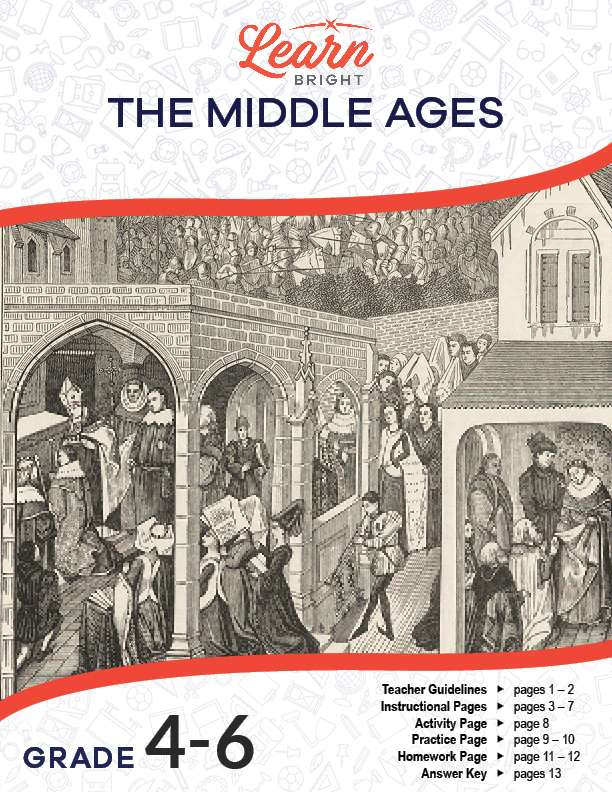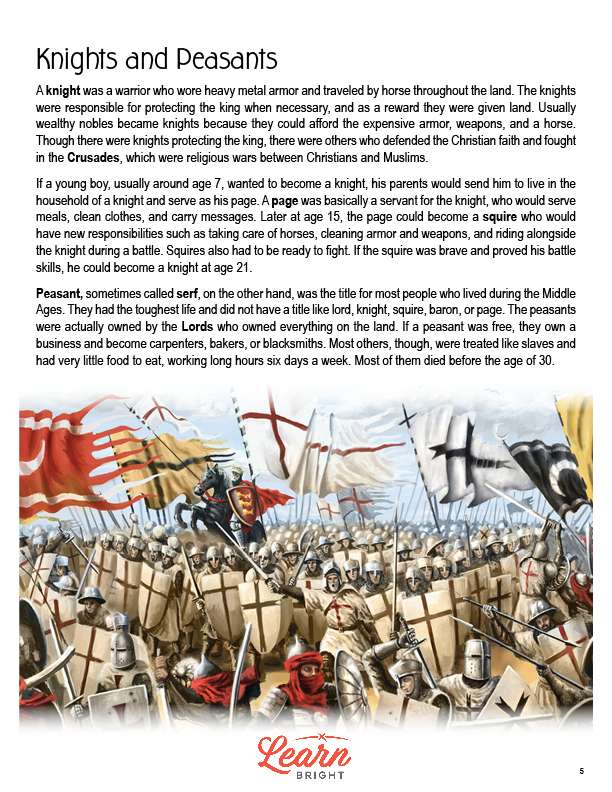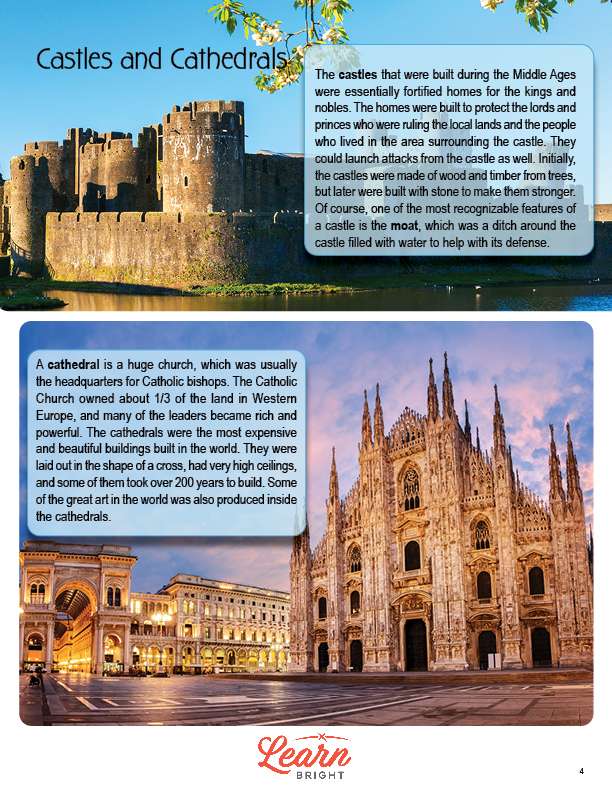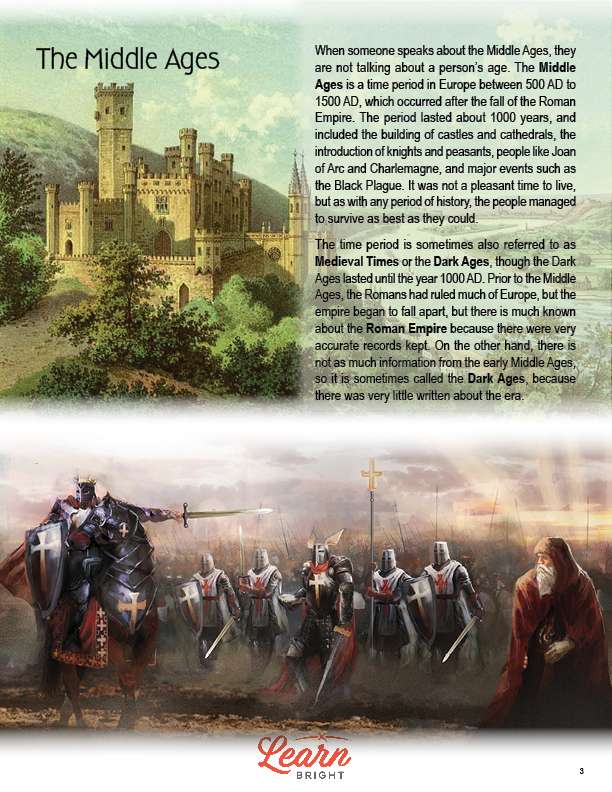Description
What our Middle Ages lesson plan includes
Lesson Objectives and Overview: Middle Ages lesson plan introduces students to the Middle Ages, which they likely know little about. At the end of the lesson, students will be able to define the Middle Ages, identify various people and events during the time period, and create a personal coat of arms. This lesson is for students in 4th grade, 5th grade, and 6th grade.
Classroom Procedure
Every lesson plan provides you with a classroom procedure page that outlines a step-by-step guide to follow. You do not have to follow the guide exactly. The guide helps you organize the lesson and details when to hand out worksheets. It also lists information in the orange box that you might find useful. You will find the lesson objectives, state standards, and number of class sessions the lesson should take to complete in this area. In addition, it describes the supplies you will need as well as what and how you need to prepare beforehand. The supplies you will need for this lesson include colored pencils, construction paper, glue, scissors, and the handouts.
Options for Lesson
Included with this lesson is an “Options for Lesson” section that lists a number of suggestions for activities to add to the lesson or substitutions for the ones already in the lesson. One optional adjustment to the lesson activity is to change the allow your students to create their own design or shape. For an additional activity, you can assign each of your students a concept, event, person or other related term from the Middle Ages to research and present to the class. Finally, you could also hold a “Middle Ages Fair,” similar to a science fair, using a map to show the location of various events.
Teacher Notes
The teacher notes page includes a paragraph with additional guidelines and things to think about as you begin to plan your lesson. This page also includes lines that you can use to add your own notes as you’re preparing for this lesson.
MIDDLE AGES LESSON PLAN CONTENT PAGES
The Middle Ages
The Middle Ages lesson plan includes five content pages. When someone talks about the Middle Ages, they don’t mean someone’s age. Instead, they’re talking about a time person in Europe from 500 AD to 1500 AD, after the fall of the Roman Empire. This period in history lasted for about 1000 years. During this time, they built castles and cathedrals, introduced knights and peasants, saw famous historical figures like Joan of Arc and Charlemagne, and lived through major events like the Black Plague. This was not a nice time to live but people lived the best the could.
We sometimes also call this period the Medieval Times or the Dark Ages (though the Dark Ages actually only lasted until 1000 AD). Before the Middle Ages, the Romans ruled much of Europe. Their empire began to fall apart. We know a lot about the Roman Empire because they kept very good records. During the Middle Ages, however, they did not keep very good records, so we don’t know a lot about what happened. This is why we call them the Dark Ages.
Castles and Cathedrals
They built many castles during the Middle Ages, which were basically fortified homes for kings and nobles. They built them to protect the lords and princes who ruled the surrounding area and the people who lived in that area. It was easy for them to launch attacks from these castles. They built early castles from wood and timber, but later ones from stone, which was stronger. Moats, or ditches around the castle filled with water for extra defense, are one of the most recognizable features of these castles.
Cathedrals are huge churches and usually the Catholic bishops’ headquarters. At this time, the Catholic Church owned about 1/3 of the land in Western Europe. Many of these leaders became very rich and powerful. The cathedrals they had built were some of the most expensive and beautiful buildings in the entire world. They built them in the shape of the cross and gave them very high ceilings. Some of these buildings took over 200 years to build! Some of the greatest art in the world was created inside of the cathedrals.
Knights and Peasants
Knights were warriors who wore heavy armor and traveled by horse. Their job was to protect the king. In return, the king gave them land. Wealthy nobles often became knights because they could afford the armor, weapons, and horses. While some knights protected the king, others defended the Christian faith by fighting in the Crusades (religious wars between Christians and Muslims).
Parents sent their young boys, usually about 7 years of age, who wanted to become knights to live in the house of a knight as his page. Pages were servants for the knight who served meals, cleaned clothes, and carried messages. At 15, they could become squires with new responsibilities like taking care of the horses, cleaning their armor and weapons, and riding with their knight during battle. Squires who proved their worth could become knights at age 21.
Most people during this time were not knights, but were peasants, or serfs, instead. They had hard lives and did not have titles like lord, knight, squire, baron, or page. Lords owned the peasants who lived on their land. Free peasants could own businesses and become carpenters, bakers, or blacksmiths. However, most acted as slaves, had little food to eat, and worked long hours six days a week. Most peasants died by age 30.
Joan of Arc and Charlemagne
Joan of Arc began as a peasant but became a military leader. She had a vision of Michael the Archangel at age 12. He told her that she would lead the French in battle against the English. She had these visions for many years and eventually decided to become a fighter. She had to convince the king to let her become a leader of soldiers. Eventually, she led an attack on the English, saving the French. During this fight, the English captured and sold her. They burned her at the stake at 19 years old for dressing as a man.
Charlemagne was a great leader during this time. He was King of the Franks, a tribe living in the area we now know as France. During his reign, he expanded the Frankish Empire into what is now Germany. He conquered many lands, including Rome, and became emperor of the Romans over the Holy Roman Empire. People respected him because he treated them well and let them keep their local customs in place when he conquered them. We often call him the “Father of Europe.”
The Black Plague
The Black Plague, also known as the Black Death, was a deadly disease that ravaged Europe between 1347 and 1350. It was very contagious and there was no cure. Almost 800 people died a day, and between 75 and 200 million died from it overall. The disease came from Asia by fleas that lived on rats on the ships bringing people to Europe. The Black Plague lasted about four years, but it took them 150 years to rebuild Europe.
We have much more information about the Middle Ages, including other significant people and events that affected this time period and the future.
MIDDLE AGES LESSON PLAN WORKSHEETS
The Middle Ages lesson plan includes three worksheets: an activity worksheet, a practice worksheet, and a homework assignment. You can refer to the guide on the classroom procedure page to determine when to hand out each worksheet.
COAT OF ARMS ACTIVITY WORKSHEET
For the activity worksheet, students will create a Coat of Arms. They will first draw a plain Coat of Arms like the one shown on the worksheet. They will then use the guide to add different things to their Coat of Arms. For example, in spot “A,” shown on the worksheet, they will draw the most important thing in their life.
MIDDLE AGES PRACTICE WORKSHEET
The practice worksheet asks students to define different terms, places, events, and people related to the Middle Ages.
Students may work in pairs to complete this worksheet.
CROSSWORD HOMEWORK ASSIGNMENT
For the homework assignment, students will complete a crossword puzzle using clues related to the lesson material.
Worksheet Answer Keys
This lesson plan includes an answer key for the homework assignment. If you choose to administer the lesson pages to your students via PDF, you will need to save a new file that omits these pages. Otherwise, you can simply print out the applicable pages and keep these as reference for yourself when grading assignments.









